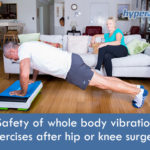
Beginner’s Guide to WBV Machines: What You Need to Know
If you are someone whose workout routine is becoming a bit stale or your lifestyle has kept you physically stagnant...

The lymphatic system plays a crucial role in your bodily...

Simply put, your muscles contract and relax in response to...

If you keep hearing more about the vibration plate lately,...

If you are suffering from back pain or lower back...

Whole body vibration exercises may not seem the safest choice...